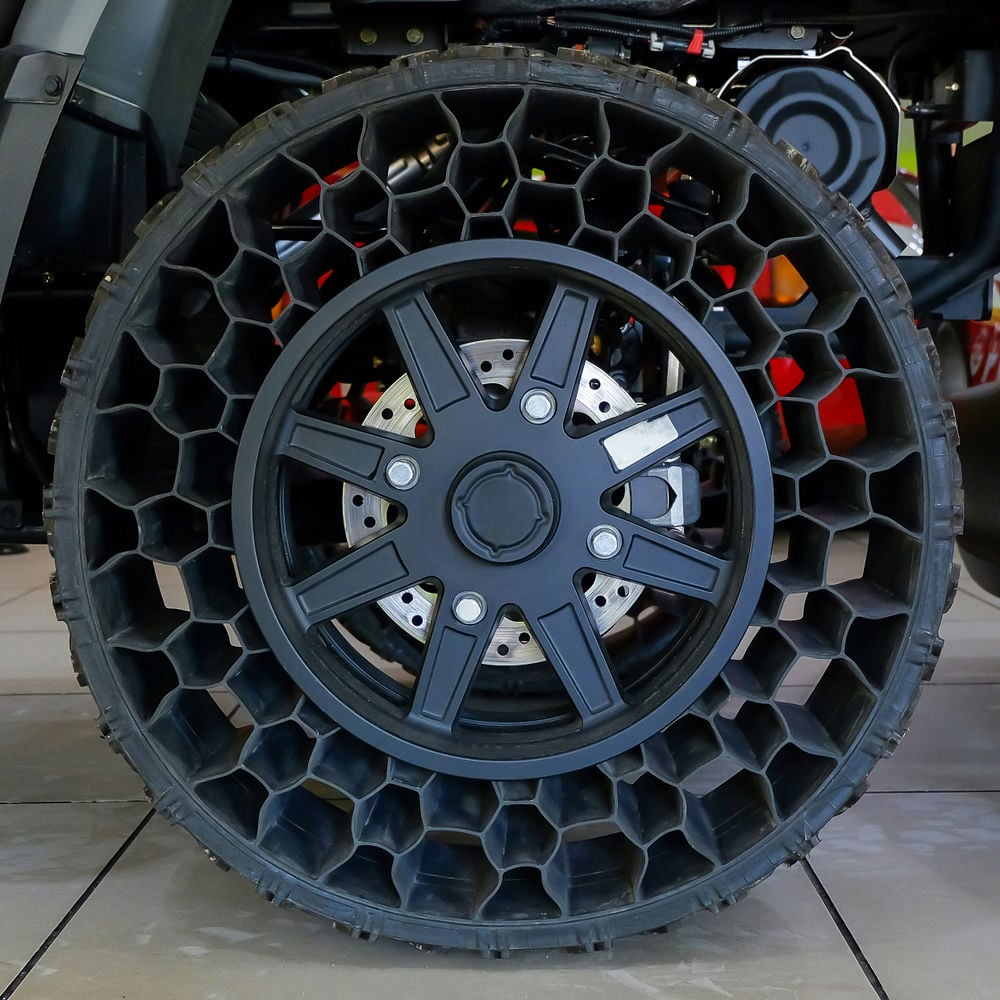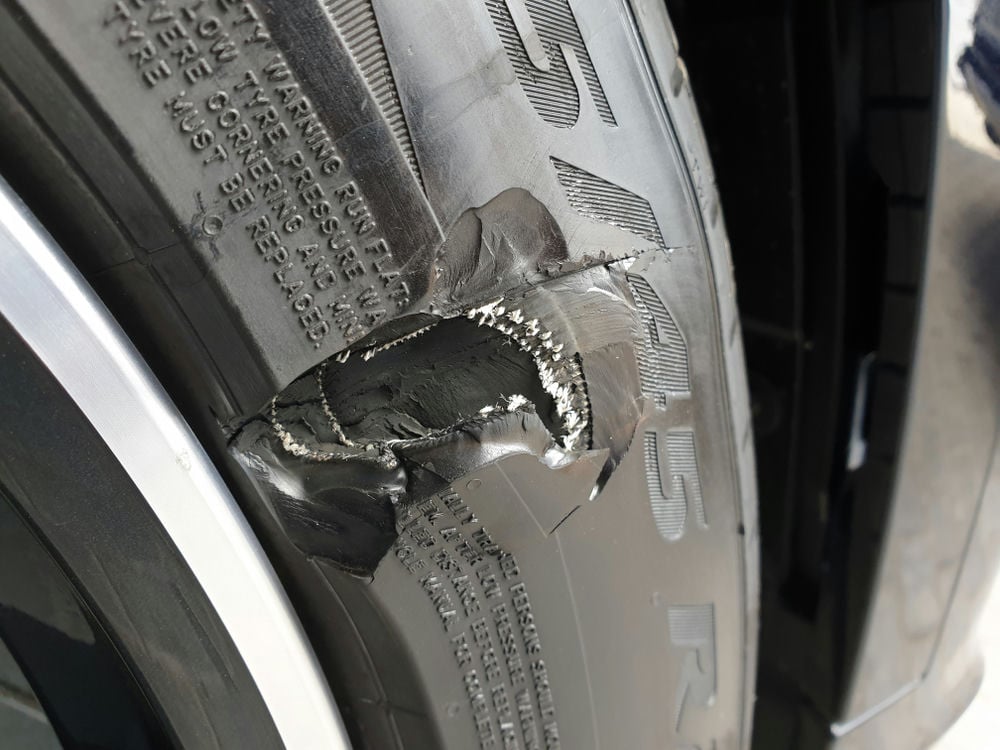
Run-flat tires (RFTs) have a reinforced design that allows them to rotate
even when the air pressure is low. However, Run-flat tires do have
trade-offs, including noise.
Run-flat tires are noisier than their conventional counterparts. This
is because their sidewalls are heavily reinforced. Hence they tend to
create and transfer slightly louder road noise into your car's cabin.
The slightly thicker design of run-flat tires makes your ride more bumpy
than usual. Let's look at some important aspects of run-flat tires.
 Run Flat tire cutaway.
Run Flat tire cutaway.
What Does a Run-Flat Sound Like?
A run flat produces road noise similar to that of a regular tire. But
with their reinforced sidewalls, the sound they produce, combined with
the vibration from the chassis, may sound loud when heard from inside
the cabin.
Run-flat tires have thick sidewalls lined with rigid rubber inserts. This
design feature helps them support the vehicle's weight even when their air
pressure is low.
When it is full of air, the thick material gives less while moving on the
road and emits a humming noise similar to a new regular tire, only a bit
louder.
What Are The Disadvantages Of Run-Flat Tires?
The disadvantages of run-flat tires include the following:
-
Noisy rides.
-
Diminished ride quality.
-
Premium price.
-
Less shelf availability.
-
Accelerated tread wear.
-
Difficulty in judging air pressure.
There are many disadvantages of run-flat tires.
Noise
Because of their stiff and thicker material, RFTs tend to be noisier than
their conventional counterparts. The noise is especially noticeable when
you are driving over a rough path.
Harsh Ride
The stiffness of the material makes run-flat tires less giving. So, your
ride becomes quite rough and harsh as the tires bounce up and down over
each small bump.
Higher Cost
In comparison with standard tires, a run-flat tire tends to cost more. The
price difference starts at $150 and can go up to $500 for each tire.
It all depends upon the size and type of the RFT. The bigger its size, the
costlier the run-flat tire will be.
Hard to Diagnose
With a conventional tire, you can easily guess that the air pressure is low
when it appears deflated. The same does not hold for RFTs. You must check
the Tire Pressure Monitoring System (TPMS) or use a tire gauge to learn
about their air pressure.
Limited Availability
Run-flat tires are only available in limited sizes and tread designs. Not
every tire shop stocks these.
Frequent Replacement
When your run-flat tire punctures, there is little to no chance of
repairing it. You'll have to replace the punctured RFT with a new one.
Their tread also wears more quickly, so you'll find yourself replacing
these tires more often than the standard ones.
 A thick walled run flat tire.
A thick walled run flat tire.
Do Run-Flat Tires Have A Rougher Ride?
Yes, run-flat tires have a rougher ride. They are stiff and tend to
pound harder when driven over bumps and cracks, resulting in diminished
ride quality.
The sidewalls of conventional tires measure about ⅛ inch. On the other
hand, a run-flat tire has thicker ¾ inch sidewalls, making it stiffer and
less conforming.
Where conventional tires adapt themselves to absorb the impact of a bump,
RFT tires harshly pound over them, resulting in a harsher ride.
How Long Do Run Flats Last?
If cared for and maintained correctly, run flats can last 3 to 5 years.
However, once an RFT is punctured, you may be able to drive with it up
to 50 miles at 50 mph speed.
Different brands differ in the number of years that their run-flat tires
last. Generally, an RFT is expected to last for 3 to 5 years if properly
taken care of.
Here are some tips to extend its lifespan:
-
Never mix run-flat tires with regular ones, as both have different
characteristics.
-
Keeping them inflated at the correct air pressure prolongs run-flats
life.
-
Keep them inflated, even when storing them for the season.
-
Clean them thoroughly before storage.
-
Once an RFT gets punctured, reduce your driving speed. Now refer to
your driver's guide to determine how far you can safely drive and at
what speed.
Do Run Flat Tires Wear Out Faster?
Yes, run flats tend to wear out faster than most conventional tires.
This may be because these tires are designed with a softer tread
compound that counterbalances the rough ride but wears out quickly.
The tread compound put on run-flat tires is a combination of silica and
special rubber polymers. The compound makes the tread more pliable to
cushion the road impact. But also causes these tires to wear out more
quickly.
Conclusion
Many manufacturers have started equipping their cars with run flats to
reduce load, maximize cargo space, and improve fuel efficiency. However,
before committing to a set, you should carefully weigh its benefits and
shortcomings.
These tires are designed with reinforced sidewalls that hold the vehicle's
weight even when the air pressure is low.
Yet, RFTs are noisier and costlier and provide a rough riding experience.
If your run-flat tire becomes punctured, you can safely drive it up to 50
miles at a slow speed to reach a repair shop or any other safe destination.